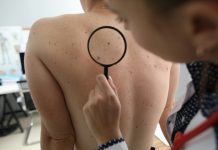
In a new research article, researchers provide important information about melanoma, the most dangerous type of skin cancer.
The research was written by a team from the University of Toronto.
Melanoma, also known as malignant melanoma, is a type of cancer that develops from the pigment-containing cells known as melanocytes.
In women, they most commonly occur on the legs, while in men they are most common on the back.
Sometimes they develop from a mole with changes such as an increase in size, irregular edges, change in color, itchiness, or skin breakdown.
According to the researchers, there are five things everyone needs to know about skin cancer:
Sun exposure is an important factor in the development of melanoma.
Research has shown that the primary cause of melanoma is ultraviolet light (UV) exposure in those with low levels of skin pigment.
Genetic mutations can also lead to melanoma. A number of rare mutations, which often run in families, greatly increase melanoma risk.
That is why melanoma often appears in the skin area where sun exposure is common.
Melanoma can also occur on areas with minimal sun exposure, such as palms and soles of the feet. It can also rarely happen in the mouth, intestines, or eye.
A specific mitogen-activated pathway is linked to genetic mutations causing melanoma and genomic sequencing is helping identify markers for diagnosis and treatment.
About 10% of melanomas are hard to diagnose as they may be pink, red, clear or normal skin-colored.
Patients with any suspicious skin lesions should be referred to dermatology.
Early signs of melanoma are summarized by the mnemonic “ABCDE” — Asymmetric shape, irregular Borders with edges and corners, Color variation, Diameter greater than 6 mm (about the size of a pencil eraser) and Evolving over time.
For nodular melanoma, symptoms also include elevated above the skin surface, Firm to the touch and Growing
The study is published in the Canadian Medical Association Journal.
Copyright © 2019 Knowridge Science Report. All rights reserved.



